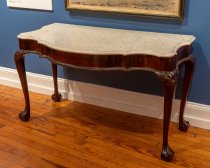Object Record
Images

Metadata
Object name |
Table |
Artist or maker |
unknown |
Place of origin |
New York, New York |
Materials and techniques |
marble, mahogany |
Physical description |
Chippendale mahogany marble top pier table. Serpentine top carved with gadrooning, ball and claw feet. |
Historical context |
The families of these owners play an important role in New York history. Robert Ludlow was born in New York and in 1796 settled in Newburgh. His father Gabriel Ludlow married Frances Duncan and through this union are descendants of the Livingston Ludlows, the Verplancks, the Dashwoods and the Carrolls of New York. One of the owners Mary Ludlow and her husband Thomas Powell were central to establishing the industrial development of Newburgh. Powell controlled most of the riverfront business and was a large stockholder in factories, railroads, banks, steamboats, docks and storehouses. Their grandson continued to prosper and owned the Newburgh-Beacon ferry, the Denning Point Brick Yards in Beacon, NY, the Washington Iron Works and he controlled all the railroads that came through Newburgh when he was president of the Erie Railroad. This table was previously on loan to the Metropolitan Museum of Art, New York (L.2011.75a,b). A similar, but less refined example which was likely made for Stephen Van Rensselaer II, sold at Sotheby's, New York, "Property from the Collection of Irvin and Anita Schorsch: Hidden Glen Farms", January 22nd, 2016, Lot 309. |
Current exhibit |
Path to Liberty: The Emergence of a Nation |
Gallery label |
Path to Liberty: The Emergence of a Nation (2025): By July 9, 1776—when the Declaration of Independence was read to the public on the Commons, and then Patriots proceeded to tear down the statue of King George III from its pedestal on Bowling Green—New York City had been a center of growing tensions between the British and American colonists for over a decade. Following the end of the Seven Years’ War in 1763, the relationship between Great Britain and its colonies grew increasingly hostile. The War had increased Britain’s debt, and in 1764 the British Parliament enacted the Sugar Act taxes and the Currency Act, which precluded the colonies from issuing their own paper currencies. Then, in 1765, the British Parliament enacted the Stamp Act, which required that printed materials—such a legal documents, newspapers and even playing cards—be printed on paper with a tax stamp. New Yorkers felt the sting of increased taxation and many were willing to actively protest. The New York Assembly of October 1764 called for an end to "involuntary taxes." In 1765, New York was the site of the Stamp Act Congress, held several blocks north of Fraunces Tavern in the old New York City Hall (now the site of the current Federal Hall). And a riot broke out in New York in November 1765, when the Stamp Act was to take effect. Frustrated colonists formed resistance movements, such as the groups of merchants, lawyers, tradesmen and others called Sons of Liberty. Across the thirteen colonies, Sons of Liberty organized boycotts, destroyed private property, harassed government officials, and circulated political writings. Britain, hoping to quell protests in the American colonies, repealed the Stamp Act in 1766, but at the same time adopted the Declaratory Act that sought to reassert Britain’s right to control the colonies. by passing a series of laws over several years that extracted money from the colonists and asserted British rule. In March of 1767, Parliament enacted the New York Restraining Act, which prevented the New York Assembly from passing new legislation until the colony agreed to contribute money and housing for British troops. Parliament then implemented the Townshend Acts throughout the summer of 1767, further raising taxes on imported items and allowing British officials to monitor the movement of people and goods at colonial ports. The Intolerable Acts of 1774 highly restricted colonial trade and local forms of government while granting British authorities more legal power in the colonies. As the British exerted more control over colonial trade and governance, American colonists felt a growing need to protect themselves. In September of 1774, delegates from 12 colonies, calling themselves the Continental Congress, met in Philadelphia to strategize their resistance to the Intolerable Acts. They not only agreed to boycott British goods but began stockpiling gunpowder and other munitions across the colonies in preparation for conflict. New York was a key battleground during the Revolution, with major engagements such as the Battle of Long Island and Battle of Saratoga taking place in the state. The colony's location, lying between New England and the Middle Colonies, made it strategically important, along with its location along the Hudson River. Control of the Hudson was key: whoever controlled the river controlled the movement of troops and supplies. New York’s defense of the river helped prevent British forces from using the crucial water route and splitting the colonies geographically. New Yorkers contributed enormously to the success of the American Revolution through military leadership and the sacrifices of its citizens. Leaders including William Alexander (Lord Stirling), Gouverneur Morris, Philip Schuyler, William Stephens Smith, and Benjamin Tallmadge, along with thousands of New Yorkers who served in the Continental Army, played crucial roles in shaping the outcome of the war. Path to Liberty commemorates the 250th anniversaries of the events and people that were central to the struggle for independence from 1775 to 1783. This dynamic eight-year display will rotate in this gallery wall-by-wall as each anniversary occurs. |
Catalogue number |
2025.02.001 |
Collection name |
Furniture and Decorative Arts |
Credit line |
Gift of Patricia Manney and Eric Gruendemann through the efforts of Craig Hamilton Weaver, 2025 |
People |
Ludlow Family Powell Family Ramsdell Family |
Subjects and places |
New York Newburgh United States |
.png)